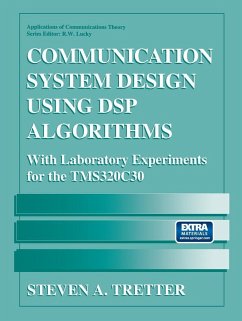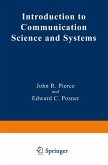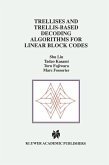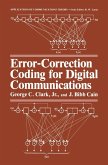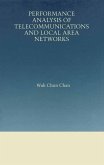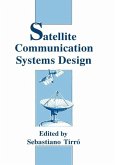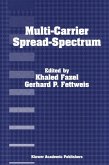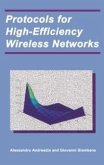Steven A. Tretter
Communication System Design Using DSP Algorithms (eBook, PDF)
With Laboratory Experiments for the TMS320C30
40,95 €
40,95 €
inkl. MwSt.
Sofort per Download lieferbar

20 °P sammeln
40,95 €
Als Download kaufen

40,95 €
inkl. MwSt.
Sofort per Download lieferbar

20 °P sammeln
Jetzt verschenken
Alle Infos zum eBook verschenken
40,95 €
inkl. MwSt.
Sofort per Download lieferbar
Alle Infos zum eBook verschenken

20 °P sammeln
Steven A. Tretter
Communication System Design Using DSP Algorithms (eBook, PDF)
With Laboratory Experiments for the TMS320C30
- Format: PDF
- Merkliste
- Auf die Merkliste
- Bewerten Bewerten
- Teilen
- Produkt teilen
- Produkterinnerung
- Produkterinnerung

Bitte loggen Sie sich zunächst in Ihr Kundenkonto ein oder registrieren Sie sich bei
bücher.de, um das eBook-Abo tolino select nutzen zu können.
Hier können Sie sich einloggen
Hier können Sie sich einloggen
Sie sind bereits eingeloggt. Klicken Sie auf 2. tolino select Abo, um fortzufahren.

Bitte loggen Sie sich zunächst in Ihr Kundenkonto ein oder registrieren Sie sich bei bücher.de, um das eBook-Abo tolino select nutzen zu können.
Designed for senior electrical engineering students, this textbook explores the theoretical concepts of digital signal processing and communication systems by presenting laboratory experiments using real-time DSP hardware. Each experiment begins with a presentation of the required theory and concludes with instructions for performing them. Engineering students gain experience in working with equipment commonly used in industry. This text features DSP-based algorithms for transmitter and receiver functions.
- Geräte: PC
- ohne Kopierschutz
- eBook Hilfe
- Größe: 21.9MB
Andere Kunden interessierten sich auch für
![Introduction to Communication Science and Systems (eBook, PDF) Introduction to Communication Science and Systems (eBook, PDF)]() John R. PierceIntroduction to Communication Science and Systems (eBook, PDF)113,95 €
John R. PierceIntroduction to Communication Science and Systems (eBook, PDF)113,95 €![Trellises and Trellis-Based Decoding Algorithms for Linear Block Codes (eBook, PDF) Trellises and Trellis-Based Decoding Algorithms for Linear Block Codes (eBook, PDF)]() Shu LinTrellises and Trellis-Based Decoding Algorithms for Linear Block Codes (eBook, PDF)113,95 €
Shu LinTrellises and Trellis-Based Decoding Algorithms for Linear Block Codes (eBook, PDF)113,95 €![Error-Correction Coding for Digital Communications (eBook, PDF) Error-Correction Coding for Digital Communications (eBook, PDF)]() George C. Clark Jr.Error-Correction Coding for Digital Communications (eBook, PDF)177,95 €
George C. Clark Jr.Error-Correction Coding for Digital Communications (eBook, PDF)177,95 €![Performance Analysis of Telecommunications and Local Area Networks (eBook, PDF) Performance Analysis of Telecommunications and Local Area Networks (eBook, PDF)]() Wah Chun ChanPerformance Analysis of Telecommunications and Local Area Networks (eBook, PDF)40,95 €
Wah Chun ChanPerformance Analysis of Telecommunications and Local Area Networks (eBook, PDF)40,95 €![Satellite Communication Systems Design (eBook, PDF) Satellite Communication Systems Design (eBook, PDF)]() Satellite Communication Systems Design (eBook, PDF)161,95 €
Satellite Communication Systems Design (eBook, PDF)161,95 €![Multi-Carrier Spread-Spectrum (eBook, PDF) Multi-Carrier Spread-Spectrum (eBook, PDF)]() Multi-Carrier Spread-Spectrum (eBook, PDF)40,95 €
Multi-Carrier Spread-Spectrum (eBook, PDF)40,95 €![Protocols for High-Efficiency Wireless Networks (eBook, PDF) Protocols for High-Efficiency Wireless Networks (eBook, PDF)]() Alessandro AndreadisProtocols for High-Efficiency Wireless Networks (eBook, PDF)113,95 €
Alessandro AndreadisProtocols for High-Efficiency Wireless Networks (eBook, PDF)113,95 €-
-
-
Designed for senior electrical engineering students, this textbook explores the theoretical concepts of digital signal processing and communication systems by presenting laboratory experiments using real-time DSP hardware. Each experiment begins with a presentation of the required theory and concludes with instructions for performing them. Engineering students gain experience in working with equipment commonly used in industry. This text features DSP-based algorithms for transmitter and receiver functions.
Hinweis: Dieser Artikel kann nur an eine deutsche Lieferadresse ausgeliefert werden.
Dieser Download kann aus rechtlichen Gründen nur mit Rechnungsadresse in A, B, BG, CY, CZ, D, DK, EW, E, FIN, F, GR, HR, H, IRL, I, LT, L, LR, M, NL, PL, P, R, S, SLO, SK ausgeliefert werden.
Hinweis: Dieser Artikel kann nur an eine deutsche Lieferadresse ausgeliefert werden.
Produktdetails
- Produktdetails
- Verlag: Springer New York
- Seitenzahl: 193
- Erscheinungstermin: 29. Juni 2013
- Englisch
- ISBN-13: 9781475797633
- Artikelnr.: 44062836
- Verlag: Springer New York
- Seitenzahl: 193
- Erscheinungstermin: 29. Juni 2013
- Englisch
- ISBN-13: 9781475797633
- Artikelnr.: 44062836
- Herstellerkennzeichnung Die Herstellerinformationen sind derzeit nicht verfügbar.
1. Brief Overview of the Hardware and Software Tools.- 2. Learning to Use the Hardware and Software Tools by Generating a Sine Wave.- 3. Digital Filters.- 4. The FFT and Power Spectrum Estimation.- 5. Amplitude Modulation.- 6. Double-Sideband Suppressed-Carrier Amplitude Modulation and Coherent Detection.- 7. Single-Sideband Modulation and Frequency Translation.- 8. Frequency Modulation.- 9. Pseudo-Random Binary Sequences and Data Scramblers.- 10. Introduction to the RS-232C Protocol and a Bit-Error Rate Tester.- 11. Digital Data Transmission by Baseband Pulse Amplitude Modulation (PAM).- 12. Fundamentals of Quadrature Amplitude Modulation.- 13. QAM Receiver I. General Description of Complete Receiver Block Diagram and Details of the Symbol Clock Recovery and Other Front-End Subsytems.- 14. QAM Receiver II. The Passband Adaptive Equalizer and Carrier Recovery System.- 15. Echo Cancellation for Full-Duplex Modems.- 16. Suggestions for Additional Experiments.- Appendix A. Communicating between the PC and EVM.- A.1. Overview of the PC/EVM Interface.- A.1.1. The Data Transfer Register.- A.1.2. EVM Interrupts to the TMS320C30.- A.1.3. Flags that Indicate to the PC when the TMS320C30 has Read or Written the Transfer Register.- A.1.4. Resetting the EVM.- A.2. A Command Passing Protocol.- A.3. Using DMA for Data Transfers.- A.3.1. TMS320C30 to PC Data Transfers.- A.3.2. PC to TMS320C30 Data Transfers.- A.3.3. Turning off the DMA.- A.4. Laboratory Experiments on Transferring Data between the TMS320C30 and PC.- A.4.1. Functions the TMS320C30 Program Must Perform.- A.4.2. Functions the PC Program Must Perform.- A.4.3. Testing Your PC and TMS320C30 Software.- Appendix B. Generating Gaussian Random Numbers.- Appendix C. A TTL/RS-232C Interface for Serial Port 1.- Appendix D. Equipment List for Each Station.- Appendix E. Software and Directory Structure.- References.- I. List of Manuals.- A. Manuals for the TMS320C30 Tools.- B. Manuals for Borland C++.- C. Assorted Manuals for Lab Test Equipment.- II. Selected Reference Books and Papers.- A. DSP Laboratory Books Using DSP Hardware.- B. DSP Laboratory Books Using Software Simulation.- C. Books on Digital Signal Processing.- D. Books and Papers on Communications.- E. Books and Papers on Error-Correcting Codes.
1. Brief Overview of the Hardware and Software Tools.- 2. Learning to Use the Hardware and Software Tools by Generating a Sine Wave.- 3. Digital Filters.- 4. The FFT and Power Spectrum Estimation.- 5. Amplitude Modulation.- 6. Double-Sideband Suppressed-Carrier Amplitude Modulation and Coherent Detection.- 7. Single-Sideband Modulation and Frequency Translation.- 8. Frequency Modulation.- 9. Pseudo-Random Binary Sequences and Data Scramblers.- 10. Introduction to the RS-232C Protocol and a Bit-Error Rate Tester.- 11. Digital Data Transmission by Baseband Pulse Amplitude Modulation (PAM).- 12. Fundamentals of Quadrature Amplitude Modulation.- 13. QAM Receiver I. General Description of Complete Receiver Block Diagram and Details of the Symbol Clock Recovery and Other Front-End Subsytems.- 14. QAM Receiver II. The Passband Adaptive Equalizer and Carrier Recovery System.- 15. Echo Cancellation for Full-Duplex Modems.- 16. Suggestions for Additional Experiments.- Appendix A. Communicating between the PC and EVM.- A.1. Overview of the PC/EVM Interface.- A.1.1. The Data Transfer Register.- A.1.2. EVM Interrupts to the TMS320C30.- A.1.3. Flags that Indicate to the PC when the TMS320C30 has Read or Written the Transfer Register.- A.1.4. Resetting the EVM.- A.2. A Command Passing Protocol.- A.3. Using DMA for Data Transfers.- A.3.1. TMS320C30 to PC Data Transfers.- A.3.2. PC to TMS320C30 Data Transfers.- A.3.3. Turning off the DMA.- A.4. Laboratory Experiments on Transferring Data between the TMS320C30 and PC.- A.4.1. Functions the TMS320C30 Program Must Perform.- A.4.2. Functions the PC Program Must Perform.- A.4.3. Testing Your PC and TMS320C30 Software.- Appendix B. Generating Gaussian Random Numbers.- Appendix C. A TTL/RS-232C Interface for Serial Port 1.- Appendix D. Equipment List for Each Station.- Appendix E. Software and Directory Structure.- References.- I. List of Manuals.- A. Manuals for the TMS320C30 Tools.- B. Manuals for Borland C++.- C. Assorted Manuals for Lab Test Equipment.- II. Selected Reference Books and Papers.- A. DSP Laboratory Books Using DSP Hardware.- B. DSP Laboratory Books Using Software Simulation.- C. Books on Digital Signal Processing.- D. Books and Papers on Communications.- E. Books and Papers on Error-Correcting Codes.
